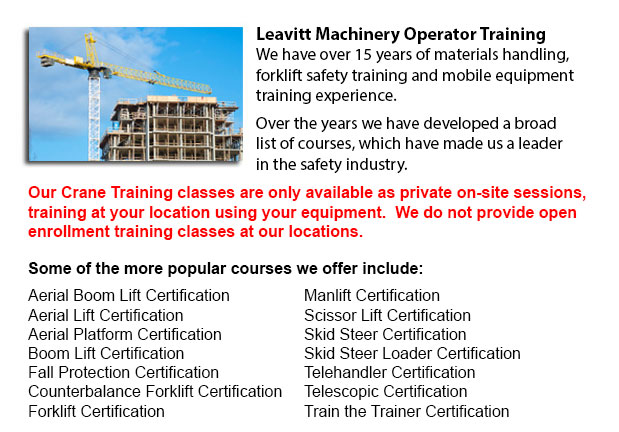
Overhead Crane Operator Training Penticton - The program teaching overhead crane operator training has been meant specifically to instruct trainees on the fundamentals of pre-shift checks and overhead crane/sling operation. The courses are instructed by expert trainers and consultants. Well-trained workers are more efficient and productive, which actually saves on expenses associated with property damage, merchandise damage, and accidents due to the utilization of incorrect operating measures. Our overhead crane certification is customized for staff who have literacy barriers, reducing certification time by 50 per cent.
Overhead cranes are suitable for specific repetitive lifting activities. This type of crane has wide ranging capacities. They may be used for specialized lifting tasks such as installing or removing major plant machines.
Worker and operators have to employ safe rigging practices in order to safely operate an overhead crane. This would need both practice and knowledge since the load has to be properly rigged to guarantee its stability when lifted. Prior to starting a hoisting job, it should be determined that the crane is right for the job, with correct lift, capacity and travel. The crane must be subjected to a thorough physical and visual inspection before use. The capacity of all equipment, including the hardware, rope and slings, should never exceed load weight capacities.
The rigger has to know the right sling for every lift and inspect slings and other rigging hardware before utilizing. Clear signals have to be used in communications with the crane operator. A signaler must be designated for the role and signals need to be agreed upon. The crane operator must follow instructions only from the designated individual. If a remote or wired controller is being utilized, the operator must be trained in all its functions.
Before whatever lifting begins, the path of the load should be cleared of all hazards and a warning sign must be issued to ensure the safety of the employees. Pedestrian are not under any circumstance allowed to walk beneath the lift loads. The crane hoist needs to be centered over the load before hoisting to prevent swinging. The safety catch has to be closed immediately after sliding the sling fully onto the hoisting hook. Unused sling legs should be secured so they do not drag. Never leave loose materials on a load being lifted. Watch that hands and fingers are clear when slack is taken out of a sling. Step clear of the danger zone before the lift is made.
-
Forklift Certification Schools Penticton
Forklift Certification Schools Penticton - In North America, forklift certification is mandatory, making forklift training programs essential for both the business and their employees working as operators of forklifts. Forklift training focuses on sa... More -
Telehandler Training Courses Penticton
Telehandler Training Courses Penticton - The employer has the responsibility to make sure that their personnel are trained to work proficiently utilizing telehandler machinery. The workers have to be assessed for their ability to utilize the machine.... More -
Certified Fall Protection Training in Penticton
There are many injuries at work linked to falling and lots of fall-related deaths reported each and every year. Most of these instances might have been prevented with better training, better precautions in place, and by properly equipping employees b... More -
Zoom Boom Training Penticton
Zoom Boom Training Penticton - Zoom Boom Training is designed to train operators on variable reach forklifts. The objectives of the training are to impart an understanding of the physics of the machine, and to outline the operator's job. This course... More -
Crane Training Schools Penticton
Crane Training Schools Penticton - We have designed various Mobile Crane Operation programs at our Crane Training Schools. These programs are recommended for the experienced operator who needs re-certification or certification, and for inexperienced... More -
Aerial Lift, Boom Lift, Man Lift, Scissor Lift Training in Penticton
Lift tables or also referred to as scissor hoists can lift up both individuals and materials vertically. They are normally utilized in industrial, construction and commercial environments. Normally, the use of a scissor forklift is to lift and lower... More -
Forklift Training Program Penticton
Forklift Training Program Penticton - The forklift is a common powered industrial vehicle which is in wide use nowadays. They are occasionally known as hi los, lift trucks or jitneys. A departments store will utilize the forklift to unload and load m... More -
Overhead Crane Training Penticton
Overhead Crane Training Penticton - An overhead crane is a large crane used to move and lift huge, heavy objects that cannot be lifted by hand. An overhead crane is normally fixed in position while in use. These machines are capable of moving huge vo... More

Forklift Training Penticton
TOLL FREE: 1-888-254-6157
Penticton, British Columbia
forklifttrainingpenticton.com
Email Us
About Us


